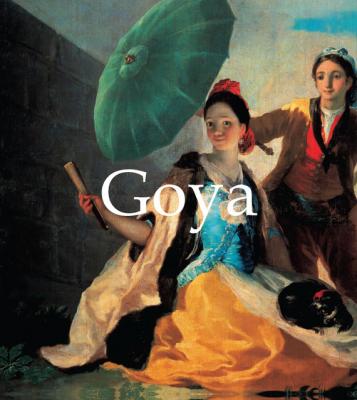ТОП просматриваемых книг сайта:
Goya. Jp. A. Calosse
Читать онлайн.Название Goya
Год выпуска 2016
isbn 978-1-78160-821-0
Автор произведения Jp. A. Calosse
Жанр Иностранные языки
Серия Mega Square
Издательство Parkstone International Publishing
“The dream of reason produces monsters. Imagination deserted by reason creates impossible, useless thoughts. United with reason, imagination is the mother of all art and the source of all its beauty.”
© Parkstone Press International, New York, USA
© Confidential Concepts, worldwide, USA
Self-Portrait, 1815.
Oil on panel, 51 × 46 cm,
Royal Academy of San Fernando, Madrid.
1746:
Francisco Goya y Lucientes is born in Fuendetodos near Sargasso, Spain. His parents were members of the rural nobility and his father was a guilder. Except for a few isolated facts and dates, we know very little about Goya’s childhood and adolescence.
1759:
At the age of 13, Goya begins studying at local painter José Luzán’s workshop, where he will stay for four years.
1763:
He leaves for Madrid where he is denied entry into the Royal Academy of San Fernando.
1766:
At 20 years of age, he again “attempts to enter The Royal Academy of San Fernando without much result.”
1767–1771:
Stays in Rome where he is influenced by roman neoclassicism. He receives a special mention at a painting competition organized by the Academy of Parma.
1771:
Receives his first commission: it is for a fresco for the vault at the Cathedral of El Pilar in Sargasso.
1773:
Settles in Madrid where he marries Josefa Bayeu whose three brothers are painters. It is here where Goya receives a commission for the Royal Factory of Santa Barbara. Within 18 years, he will produce three series of tapestries (1774–1780, 1786–1788, 1791–1792). At the same time he pursues a career as a portrait artist.
1774:
The paintings of Aula Dei.
1778:
He does engravings influenced by Velázquez.
1780:
Goya is elected a member of The Royal Academy of San Fernando. He tries to introduce himself, little by little, into the complex University system. He makes a good impression on the royal family with his drawings, which are destined for the Prado Palace. His position appears to be improving, which helps to explain his growing rebellion against the artistic supervision of his brother-in-law, Francisco Bayeu.
1785:
Nominated several days before his fortieth birthday as the Deputy Director of Painting for the Royal Academy of San Fernando.
1786:
Becomes one of the King’s painters.
1789:
Promoted and becomes a painter for the King’s Chamber.
1792:
He becomes deaf after suffering from a serious illness for many years. He begins a series of etchings that permit him to satisfy his fantasy and imagination.
1795:
Goya is nominated as the Director of Painting for the Royal Academy. The same year he paints the first portrait of the Duchess of Alba whom he falls in love with.
1797:
His illness prevents him from serving his function as Director and Goya is nominated as an honorary director.
1798:
He undertakes the decoration of The Hermitage of San Antonio de la Florida in Madrid.
1799:
Publication of the collection of eighty plates of his Los Caprichos. He becomes the First Court Painter.
1805–1810:
He paints several still lives and undertakes the eighty-two plates from the Disasters of War series, during the agitated political times marked by the war and the French occupation.
1812:
His wife Josefa Bayeu dies.
1814:
Goya paints The Second of May, 1808 and The Third of May, 1808.
1816:
Publication of The Bullfight.
1819:
Buys a country house not far from Madrid, which will become “The House of the Deaf”. There, in 1821–1822, Goya most likely realizes his so-called Black Paintings. He also does his first lithograph.
1824:
He rejoins all of his friends in exile in France.
1825:
Publication of the lithographs: The Bulls of Bordeaux.
1828:
Goya dies in April in Bordeaux.
“There are no rules in painting,” Goya told the Royal Academy of San Fernando in Madrid during an address he gave in 1792. He suggested that students should be allowed to develop their artistic talents freely and find inspiration from their own choice of masters rather than adhere to the doctrines of the neo-classical school.
Adoration of the Name of God by Angels
1772
fresco, 700 × 1500 cm
El Pilar, Saragossa
Goya himself was known to have claimed that Velázquez, Rembrandt and Nature were his masters, but his work defies neat categorization and the diversity of his style is remarkable. Francisco Goya lived for eighty-two years (1746–1828), during which time he produced an enormous body of work – about 500 oil paintings and murals, nearly 300 etchings and lithographs, and several hundred drawings.
Self-Portrait
1773–1774
oil on canvas, 58 × 44 cm
Ivercaja collection, Saragossa
He was proficient both as a painter and a graphic artist, and experimented with a variety of techniques; even at the end of his life he was a pioneer of the new printing method of lithography. Essentially a figurative painter, Goya treated an enormous variety of subjects. He became the leading portrait painter in Spain, decorated the churches of Saragossa and Madrid with altarpieces and murals, and designed tapestries illustrating life in Madrid.
Betrothal of the Virgin
1774
oil on plaster, 306 × 790 cm
Aula Dei, Saragossa
Numerous personal sketch books contain his private observations. Two catastrophic events dramatically affected Goya’s life and his vision of the world. The first came in 1792 when, at the age of forty-six, he was struck by an illness, probably an infection of the inner ear, that left him totally deaf. The second cataclysmic event was the Napoleonic invasion of Spain in 1808, which was followed by six years of fighting for Spanish independence.
The Picnic
1776
oil on canvas, 272 × 295 cm
Museo del Prado, Madrid
During the war, hideous

